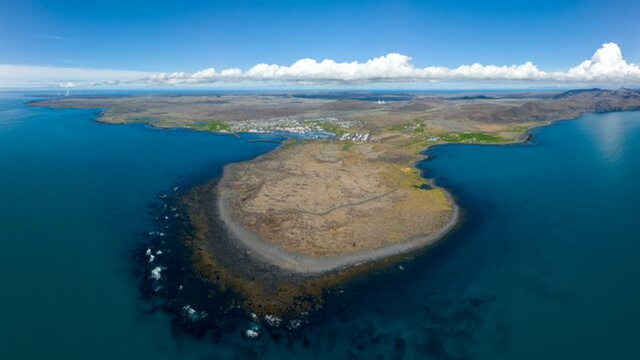Private Bespoke Reykjanes Peninsula Tour

Hópsnes Shipwreck
Explore a captivating peninsula featuring shipwrecks and remnants of old settlements, showcasing the area's rich maritime history and stunning coastal views.
Close to the town of Grindavík is a small peninsula called Hópsnes. There you can find about 10 shipwrecks and old abandoned houses. Before the current harbor at Grindavík, it was sometimes tough to enter the town’s harbor due to the strong waves and surf.
The peninsula is two kilometers long and one kilometer wide. It was formed about 2800 years ago when lava flowed into the sea. Hópsnes was created in an eruption from a series of craters named after the Sundhnúkur and is located a short distance north of the village Grindavík. Harbor barriers in Grindavík are good because of this lava flow and the lagoon created at the headland when the sea began to erode the lava and move loose material. If Hópsnes did not exist, it would not be easy to imagine a settlement in Grindavík.
When you go around the headland, you can see the wrecks of ships that ran aground there and nearby in the 20th century. Many of the wrecks have information boards on them. The first part of the 20th century was the heyday of settlement and shipping on the headland. Then many rowboats and later motorboats were made from Þórkátlustaðanes. Relics of the now-gone settlement can be seen in many places, such as entrance cairns, fish drying sheds, icehouses, fish processing houses, liver smelters, and salt huts. The fishing operation moved to what is now Grindavíkurhöfn Harbour in 1939. Hópsnesviti was built in 1928.
The peninsula is two kilometers long and one kilometer wide. It was formed about 2800 years ago when lava flowed into the sea. Hópsnes was created in an eruption from a series of craters named after the Sundhnúkur and is located a short distance north of the village Grindavík. Harbor barriers in Grindavík are good because of this lava flow and the lagoon created at the headland when the sea began to erode the lava and move loose material. If Hópsnes did not exist, it would not be easy to imagine a settlement in Grindavík.
When you go around the headland, you can see the wrecks of ships that ran aground there and nearby in the 20th century. Many of the wrecks have information boards on them. The first part of the 20th century was the heyday of settlement and shipping on the headland. Then many rowboats and later motorboats were made from Þórkátlustaðanes. Relics of the now-gone settlement can be seen in many places, such as entrance cairns, fish drying sheds, icehouses, fish processing houses, liver smelters, and salt huts. The fishing operation moved to what is now Grindavíkurhöfn Harbour in 1939. Hópsnesviti was built in 1928.

Bridge between continents
Experience a unique geological wonder where tectonic plates drift apart, offering stunning fissures and a bridge that showcases the Earth's dynamic forces.

Reykjanes Lighthouse
This historic lighthouse, built in 1878, offers stunning coastal views and a glimpse into maritime history, attracting visitors with its scenic beauty.

Eldey
This small, towering island is a birdwatcher's paradise, featuring the largest colony of northern gannets, attracting nature enthusiasts and photographers al...

Gunnuhver
This geothermal site features the largest mud pool, vibrant steam vents, and bubbling springs, all steeped in local folklore about a mischievous ghost.

Brimketill
This naturally formed ocean pool offers stunning views from a nearby platform, though swimming is unsafe due to powerful crashing waves.

Hópsnes Shipwreck
Explore a captivating peninsula featuring shipwrecks and remnants of old settlements, showcasing the area's rich maritime history and stunning coastal views.

Kleifarvatn
This deep lake features stunning lava formations and a unique hot spring, offering breathtaking views and excellent photography opportunities.

Seltún
This geothermal area features vibrant mud pools, boiling water, and stunning earth colors, offering a unique and aromatic experience for adventurous tourists.

The Blue Lagoon
This geothermal spa features vibrant blue waters rich in silica, algae, and minerals, set against a stunning backdrop of dark mountains and lava fields.

Fagradalsfjall (Meradalir) Eruption
Experience a unique hiking adventure to a stunning volcanic site, featuring diverse terrains and guided insights into its fascinating geological history.

Garðskagaviti
This location features two lighthouses and is a prime spot for birdwatching and whale sightings, attracting nature enthusiasts and photographers alike.

Hvalsneskirkja
Hvalsneskirkja is one of those beautiful and isolated Icelandic black churches. It is a popular spot during winter, especially when the Northern Lights are out.